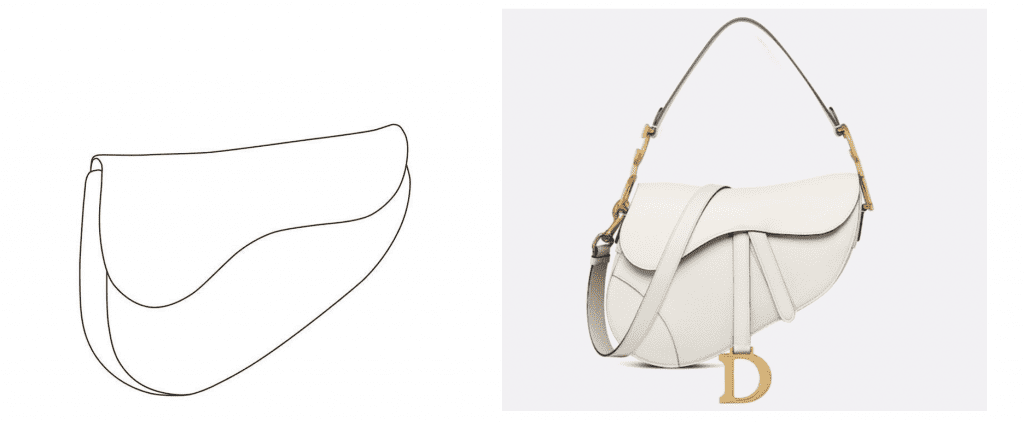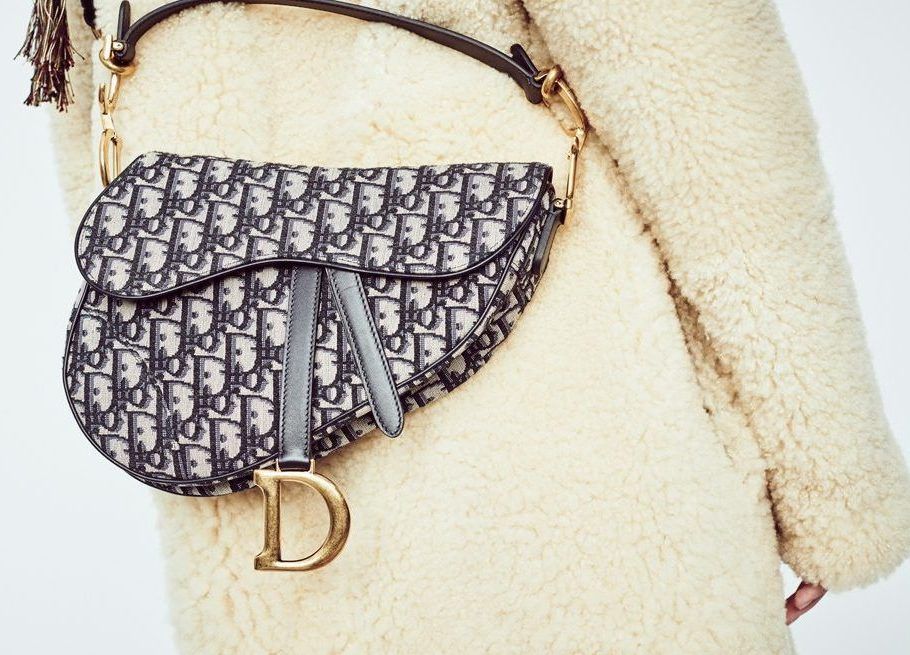The shape of Christian Dior’s Saddle bag is not a significant enough departure from the typical designs coming out of the fashion industry to warrant a handbag-specific trademark registration. That is what the Second Board of Appeal of the European Union Intellectual Property Office (“EUIPO”) asserted in a decision early this month, refusing to register the shape of LVMH-owned Dior’s well-known handbag for use in connection with various types of leather goods, including bags, as a three-dimensional trademark, but letting Dior’s application move forward for other goods.
The Board’s determination follows from an earlier loss for Dior when an EUIPO examiner refused to register the mark (in part) on the basis that the shape lacks distinctiveness – and “would be regarded as ‘typical’” – when used on handbags, as well as eyewear and phone cases. Dior subsequently intervention from the Board of Appeal in January, arguing that the shape of the handbag – which it first filed an application for in March 2021 – does, in fact, meet the requirements for unconventional marks, as the mark is a “significant departure from the norm or customs of the sector.”

(In a nutshell, the EUIPO refused to register the mark on the basis that “relevant” consumers – namely, “average end consumers with a medium to high degree of attention” – would view the Saddle bag shape “as being typical of the shapes” of leather goods, and eyewear and phone cases. The examiner noted that such goods “come in many shapes,” and thus, “are not significantly different from the mark applied for.” The EUIPO also stated that “it is important to take into account the possible functional character” of the mark, as the shape of the Saddle bag “will be perceived as … a functional and practical shape for storing objects and not as a distinctive trademark.”)
Dior’s Appeal
Arguing for a registration of the Saddle bag trademark on appeal, counsel for Dior asserted that, among other things, the examiner failed to properly identify the relevant consumer at issue. Given the “luxurious and expensive” nature of Dior’s goods, the “relevant” consumer is part of “an audience of insiders and/or well-to-do and not at an average consumer.” As such, “it is undeniable” that consumers “will show high or at least above-average attention.” Beyond that, Dior claimed that “a brief Internet search” makes it “clear that the contested sign stands out very clearly from the forms usually encountered in the leather goods and eyewear sectors.” In furtherance of this assertion, Dior points to examples of handbags and other goods from the likes of Chanel, Louis Vuitton, and Hermès, which it says “demonstrate that the contested mark clearly diverges from the norm.”

And finally, counsel for the brand cited the July 2021 outcome on the Guerlain case (in which the EU General Court held that the shape of the Rouge G de Guerlain lipstick has “distinctive character because it departs significantly from the norm and customs of the lipstick sector”) as weighing in its favor, or “in the alternative,” it states that the shape of its bag “has acquired a distinctive character through its use.”
Refusal to Register
Reviewing the EUIPO’s decision and Dior’s subsequent appeal, the Board confirmed in its September 7 decision that “the examiner was right to refuse registration of the mark applied-for for lack of distinctive character under Article 7(1)(b) EUTMR for the products “bags, handbags; pouches (leatherware), travel cases (leatherware), toiletry and make-up cases (empty).”
The Board set the stage by stating that settled case-law establishes that “the criteria for assessing the distinctive character of 3D marks [that] consist of the appearance of the product itself are no different from those applicable to other categories of marks.” Part of the issue for Dior here, according to the Board, is that “average consumers are not used to presuming the origin of products based on their shape or that of their packaging, in the absence of any graphic or textual element.”
“Under these conditions, only a mark which, in a significant way, diverges from the norm or customs of the sector … is not devoid of distinctive character,” the Board states, noting that “it could, therefore, prove more difficult to establish the distinctive character of a 3D mark than that of a word or figurative mark.”
Siding with the EUIPO examiner, the Board took issue with a number of Dior’s arguments on appeal starting with the way the French fashion house defined relevant consumers, noting that these are luxury goods and some “may be particularly expensive.” At the same time, however, there is a “wide range of prices of the products in question,” which widens the pool of potential consumers beyond “the subset of articles of an exclusive nature put forward by [Dior].”
Echoing the determination of the EUIPO, the Board stated that “it is a well-known fact that [fashion] is characterized by a multitude and an abundance of forms to which the public is regularly exposed,” and that Dior’s mark “consists of a combination of elements of presentation that are typical of the goods concerned and therefore, does not, as a whole, deviate significantly from the norm or customs of the leather goods sector.” On the latter issue, the Board notes that “a mere departure from the norm” is not sufficient enough to avoid refusal. Instead, “the difference between the sign applied for and the norms or customs of the sector must be significant,” which is not the case here.
With the foregoing in mind, the Board upheld the Board’s decision with regard to certain leather goods, including “Bags, handbags; Pouches (leather goods),” and “glasses cases; phone cases” – but not for the other goods in classes 9 and 18 that Dior listed in its application. As a result, the application for the latter is permitted to proceed in the registration process. (It is worth noting, of course, that the remaining elements of the application are likely not particularly meaningful given that the Board struck down the Saddle bag trademark for use on bags, which the undoubtedly the real item of value here for Dior.)
The court sent the matter back before the examiner “to consider the alternative claim of distinctiveness by use of the mark within the meaning of Article 7(3) EUTMR as claimed by the [Dior].”
Reflecting on the outcome of the latest round, Eleonora Rosati, a Professor of Intellectual Property Law and Director of the Institute for Intellectual Property and Market Law at Stockholm University, stated that the decision “adds to a long string of unsuccessful attempts on the side of fashion companies to register their less conventional signs as trademarks,” with recent examples including decisions that center on Buffalo boots, Louis Vuitton’s Damier Azur pattern, Tecnica’s Moon Boots, and Eos lip balm.
“While the public interest rationale underlying the ‘significant departure’ test is something we can all agree with,” she states that “perhaps it is time to ask and understand more in detail what the actual criteria are for one to pass it and what kind of evidence can assist in this regard.” In the meantime, “it seems that Guerlain’s success in registering the shape of its lipstick case as a [registered trademark] is bound to remain the exception rather than the rule.”
Meanwhile, in the U.S., Dior previously sought to register the shape of its Saddle bag as a 3D mark for use on “coin purses; bags in the nature of purses, clutches and handbags; handbags; leather clutch bags,” but abandoned that application following pushback from the U.S. Patent and Trademark Office. An application for registration for just the shape of the flap of the bag – more specifically, “a two-dimensional design with a straight line across the top with a curved line extending from the left side of the straight line down and to the right connecting on the right to the top line” – for use in Classes 9, 18, and 25 is currently pending before the USPTO.











